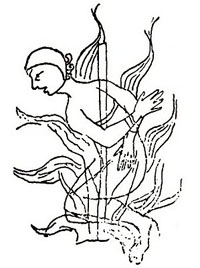The Historia is one of the principal primary sources for events during 1203 to 1208, including the first ten years of the wars against the people of the Languedoc, known to the Roman Catholic Church as the Albigensian Crusade. It also covers some of the events leading up to the Crusade.
There is now an English translation of the Historia albigensis called the History of the Albigensian Crusade.
|
The author the Historia albigensis was a Cistercian monk from the Abbey of les Vaux de Cernay in France. He wrote it between 1212 and 1218.
Peter's account is valuable because he was an eye witness to many of the events described, and thanks to his uncle Guy, he was personally acquainted with many of the Crusade leaders. Peter know and admired Simon de Montfort who led the Crusade from the siege of Carcassonne to his death in 1218. It is thought that Peter must have died soon after wards since his account stops in 1218 and is clearly unfinished. |
|
The text is partisan in favour of Simon de Montfort and the Crusaders. Peter has no doubt at all that people who presumed to chose their own faith deserve to die, and so do those who fail to persecute them severely enough. To Peter, Simon is unashamedly "our Count" (comes noster) - and the Crusaders are "our men" (nostri). As W.A. and M.D. Sibly point out in their Introduction to the English translation of the Historia:
"Those who oppose the Crusade are portrayed in the worst possible light, usually branded as heretics or supporters of heresy, acting from base motives. Peter especially loathed Raymond VI, Count of Toulouse (who became the main target of the Crusade), and Count Raymond-Roger of Foix, and the Historia abounds with denunciations of them with details of their alleged iniquities. They are the agents of Satan in what is portrayed as an almost Manichean struggle between good and evil - which may now seem ironic, given the dualist beliefs of the Cathars whom Peter so detested."
Peter had no understanding of the culture, values and society of the Languedoc. The concept of paratge, so essential in the Canso (or Song of the Cathar Wars), our other main source of information for the events portrayed in the Historia, seems to be unknown to Peter. His credulity and gullibility have attracted much derision and some historians dismiss him as entirely unreliable. Here are the Siblys again:
"... doubts about his reliability have focused mainly on the fact that his account is highly partisan, sometimes (to modern eyes) almost ludicrously so. Certainly his approach to writing the Historia reflected his background and education, his close involvement with the leaders of the Crusade, and his inability to understand or even record the attitudes of the Crusade's opponents. His detestation of heresy and those he believed supported it was deeply ingrained. For him there was no grey area between good and evil, so that any opponent of the crusaders was ipso facto a heretic or supporter of heretics. It was beyond him to think that the southern lords and King Peter of Aragon might have had a legitimate point of view. His prejudice is so great and so manifest that at times it is tempting to think of him as a mere propagandist, perhaps even a cynical propagandist."
The alternative posibility is that he is merely naive: an unsophisticated zealot unable to think outside of his limited milieu, a victime of French Catholic indoctrination, a young man who never thought to question what his uncle told him, a simple innocent who had learned to write well enough but not to think.
Either way it is possible to compensate for Peter's bias, since it is so blatant and so consistent. For example, whenever he speaks briefly of an incident saying that Simon de Montfort "gained honour and credit for his conduct" we can be certain that Peter is referring to a military engagement where Simon came second.
Available Modern Versions
|
A text in the original Latin with accompanying narrative and footnotes by Pascal Guébin and Ernest Lyon is available: Petri Vallium Sarnaii monachi Hystoria albigensis (Paris, 1939) and also a French translation, Histoire albigeoise in 3 volumes by Pascal Guébin and Henri Maisonneuve (Paris, 1951) There is now an English translation of the Historia albigensis by W.A.Sibly and M.D. Sibly. It is called the History of the Albigensian Crusade and is published by the Boydell Press. The bias of Pierre Des Vaux de Cernay is compensated for by extensive accurate footnotes, which make frequent reference to other contemporary sources. Similarly the writer's frequently inaccurate chronology is corrected. An Extract. Click on the following link to read part of the English translation by W.A. and M.D. Sibly (Boydell, 1998) of sections 171 to 192 of chapter 7 of the Historia Albigensis by Pierre des Vaux-de-Cernay which deals with the siege of Termes |
|
 |




 The
Abbey of les Vaux de Cernay lies about 35km south-west of
Paris. It had close connections with the de Montfort family,
whose family seat lay nearby. The abbey had been founded
by
The
Abbey of les Vaux de Cernay lies about 35km south-west of
Paris. It had close connections with the de Montfort family,
whose family seat lay nearby. The abbey had been founded
by 



